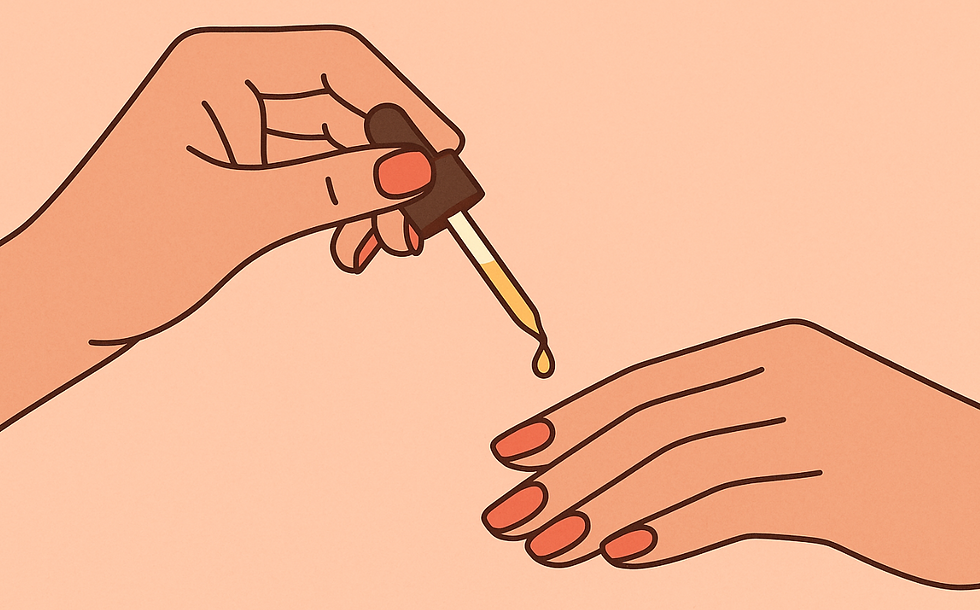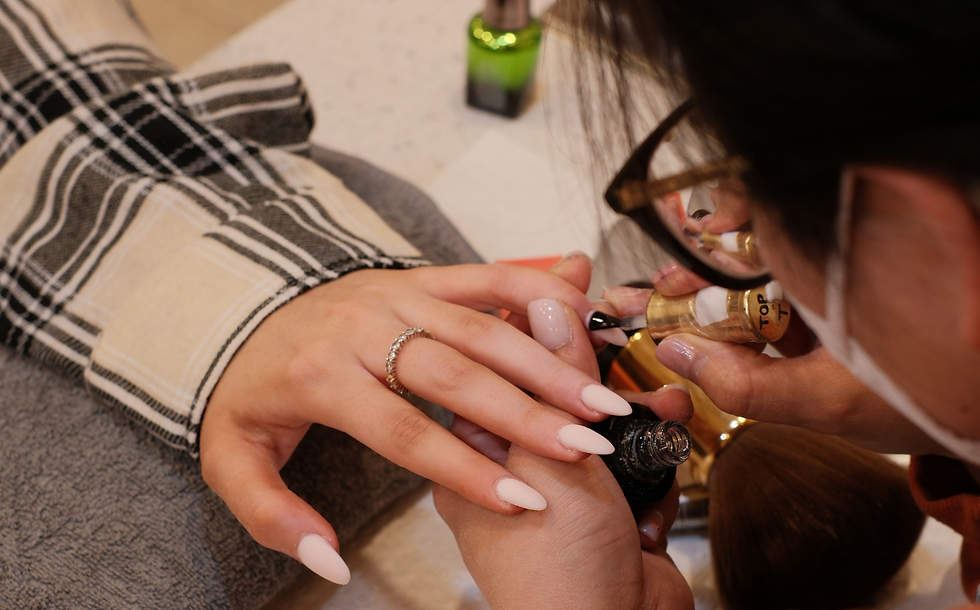How To Remove BIAB Nails At Home Safely
- Andy Nguyen
- Jul 17
- 4 min read

As a nail salon specialising in BIAB nails in Brisbane, we know that popping into the salon isn’t always possible. When that happens, removing your nails at home can seem like the best option.
If that’s the case, don’t worry - we’ve got you. This guide will take you through exactly how to remove BIAB nails at home, step by step, safely and effectively. Let’s get started!
Why Is BIAB So Hard To Remove?
BIAB can be tricky to remove as it's a tough, long-lasting gel that’s made to reinforce your nails. Unlike regular gel polish or shellac, it doesn’t come off easily with standard removers. To take biab nails off safely without harming your natural nails, you’ll need a bit of patience and the right tools.

Can You Remove BIAB Nails At Home?
Yes, you can remove BIAB nails at home if you’re short on time to visit the salon, but it’s important to look up the proper techniques and tips beforehand to make sure you do it safely and effectively.
Step-By-Step: How To Remove BIAB Nail
Essential Tools For BIAB Removal
Having the right tools ready makes removing BIAB much easier, and keeps your natural nails safe in the process.
Acetone
Aluminum foil
Cotton pads
Cuticle pusher
Nail file
Nail buffer
Cuticle oil
Hand cream
Here is a step-by-step guide on how to remove BIAB nails at home using safe and effective techniques.
Step 1: File The Top Layer
Start by gently filing the top layer of your BIAB nails with a nail file. The aim is to remove the glossy finish so the acetone can soak in and work its magic, no need to press too hard, just a light buff will do.

Step 2: Soak Cotton Pads In Acetone
Next, soak some cotton pads in pure acetone until they’re fully wet. You might be wondering if acetone removes BIAB. The answer is yes. Acetone helps break down the builder gel, making it soft and easier to take off without harming your natural nails.
Step 3: Apply Cotton Pads To Nails
Place the soaked cotton pads directly onto each nail. Make sure the gel surface is fully covered for effective soaking.

Step 4: Wrap Nails With Foil
After putting the acetone-soaked cotton pads on your nails, wrap each finger with foil. This keeps the pads in place and stops the acetone from drying out, so it works better to remove the gel.
Step 5: Wait 10-15 Minutes
Soak your nails for 10–15 minutes, depending on how thick the BIAB gel is. The acetone breaks down the gel’s polymer bonds, causing it to soften and lift. Once the gel starts to lift or bubble, it’s ready to be removed.
Step 6: Remove Foil And Cotton Pads
Carefully remove the foil and cotton pads. The BIAB gel should be soft, so take care not to be too rough.
Step 7: Gently Push Off Remaining BIAB
Gently push off the softened BIAB gel using a cuticle pusher or orange stick. Don’t scrape or force it, as this can harm your nails. If any gel is still stuck, rewrap your nails and soak for a bit longer.

Step 8: Buff Your Nails
Once all the gel is off, use a nail buffer to smooth the surface. It helps remove any leftover bits and gets your nails ready for polish or a break.
Step 9: Remove Any Leftover Residue
If a few gel spots remain, gently push or buff them away. Take your time as your nails should feel smooth and healthy, not scratched or worn down.
Step 10: Moisturise Your Nails And Cuticles
Finally, apply cuticle oil and hand cream to rehydrate your nails and skin. Acetone can be drying, so this step is important for gentle removal and nail health.

Fixing Common Problems When Removing BIAB Nails
If the gel isn’t coming off easily, soak your nails again for another 10–15 minutes.
If you’re scraping too hard, gently push the softened gel with a cuticle pusher to avoid damage.
If your skin or cuticles feel irritated, take a break and apply petroleum jelly or moisturiser.
If your nails feel scratched or thin, use a buffer lightly and avoid over-filing.
If you're not confident with BIAB nail removal at home, consider booking a professional reapplication at our Brisbane salon for the safest results.

Frequently Asked Questions
How To Remove BIAB Nails At Home Without Acetone?
To remove BIAB nails at home without acetone, you can try gently filing down the top layers using a fine-grit nail file. Take your time and avoid filing too close to the natural nail to prevent damage. Once most of the product is removed, you can buff the surface and apply cuticle oil to keep your nails healthy. It’s not the fastest method, but it’s a gentler option if you’d rather avoid acetone.
Does BIAB Need To Be Removed Every Time?
No, BIAB doesn’t need to be completely removed every time. In most cases, your nail technician will simply file down the top layer and infill the regrowth, which helps maintain the strength and shape without starting from scratch. Full removal is usually only needed if you're switching styles, colours, or if there's lifting or damage.
What Happens If You Leave BIAB On For Too Long?
If you leave BIAB on for too long without proper maintenance, it can start to lift, crack or weaken the natural nail underneath. This increases the risk of moisture getting trapped which may lead to infections or damage. It is best to follow regular infill or refresh appointments, typically every 2 to 3 weeks, to keep your nails healthy and looking their best.
Does Removing BIAB Damage Nails?
Yes, taking off BIAB the wrong way can damage your nails. Picking or peeling it can make them thin, weak, and flaky. It’s best to soak in acetone and remove it gently.
Conclusion
Knowing how to remove BIAB nails properly helps keep your natural nails healthy and strong after each removal. The best method involves filing down the top layer, soaking with acetone using cotton pads and foil, patiently waiting for the gel to soften, and gently pushing off the residue. Avoid peeling or harsh scraping, and always moisturise your nails afterwards.
Whether you do it yourself or visit a salon, understanding how to take BIAB nails off safely and efficiently will save you time and prevent damage. Follow these steps and tips for a smooth, gentle removal every time!




Comments